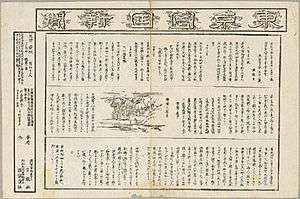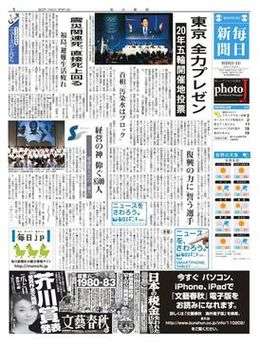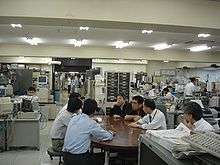Mainichi Shimbun
The Mainichi Shimbun (毎日新聞, literally "Daily News") is one of the major newspapers in Japan, published by The Mainichi Newspapers Co.[5][6]
 First issue Mainichi Shimbun on February 21, 1872. | |
| Type | Daily newspaper |
|---|---|
| Format | Broadsheet (54.6 cm × 40.65 cm) |
| Owner(s) | The Mainichi Newspapers Co., Ltd. |
| Publisher | Masato Kitamura |
| Founded | February 21, 1872 |
| Political alignment | Centre[1] to centre-left[2] Liberalism |
| Language | Japanese |
| Headquarters | Chiyoda, Tokyo Osaka Nagoya Kitakyushu |
| Circulation | Morning edition: 3,945,646 (2005) 3,091,699 (2016)[3] Evening edition: 1,610,293 (2005)[4] |
| Website | www |


In addition to the Mainichi Shimbun, which is printed twice a day in several local editions, Mainichi also operates an English language news website called The Mainichi[7] (previously Mainichi Daily News), and publishes a bilingual news magazine, Mainichi Weekly. It also publishes paperbacks, books and other magazines, including a weekly news magazine, Sunday Mainichi.
History
The history of the Mainichi Shinbun began with the founding of two papers during the Meiji period. The Tokyo Nichi Nichi Shimbun was founded first, in 1872. The Mainichi claims that it is the oldest existing Japanese daily newspaper with its 136-year history. The Osaka Mainichi Shimbun was founded four years later, in 1876. The two papers merged in 1911, but the two companies continued to print their newspapers independently until 1943, when both editions were placed under a Mainichi Shimbun masthead. In 1966, the Tokyo office was moved from Yurakucho to Takebashi, and in 1992, the Osaka office was moved from Dojima to Nishi-Umeda.
The Mainichi has 3,200 employees working in 364 offices in Japan and 26 bureaus overseas. It is one of Japan's three largest newspapers in terms of circulation and number of employees, and has 79 associated companies,[8] including Tokyo Broadcasting System (TBS), Mainichi Broadcasting System (MBS) and the Sports Nippon Newspaper.[9] (despite affiliation, the Mainichi does not own the largest stock in TBS nor in MBS)
The Mainichi is the only Japanese newspaper company to have won a Pulitzer Prize, for the 1960 photograph "Tokyo Stabbing". The Japan Newspapers Association, made up of 180 news organizations, has granted the Mainichi its Grand Prix award on 21 occasions, making the Mainichi the most frequent winner of the prize since its inception in 1957.
Partnership with MSN
On 15 January 2004, Mainichi Shimbun and MSN Japan announced they were to merge their websites. The partnership has been known as MSN-Mainichi Interactive, effective since 1 April 2004.[10] On 18 September 2007, Mainichi announced the launch of their new website, mainichi.jp, which would include "heavy use of social bookmarking, RSS and blog parts" and would "pay attention to bloggers". The new website began operations on 1 October 2007, marking the end of MSN-Mainichi Interactive, being replaced by mainichi.jp. The English-language Mainichi Daily News also moved to the new website.[11] MSN-Japan switched to Sankei Shinbun.[12]
WaiWai controversy and cancellation
The Mainichi Daily News column WaiWai, by Australian journalist Ryann Connell, featured often-sensationalist stories, principally translated from and based on articles appearing in Japanese tabloids. The column carried a disclaimer since September 19, 2002: "WaiWai stories are transcriptions of articles that originally appeared in Japanese language publications. The Mainichi Daily News cannot be held responsible for the content of the original articles, nor does it guarantee their accuracy. Views expressed in the WaiWai column are not necessarily those held by the Mainichi Daily News or the Mainichi Newspapers Co."[13] Nevertheless, WaiWai content was reported as fact in blogs and reputable foreign media sources.[14]
In April and May 2008, an aggressive anti-WaiWai campaign appeared on internet forums including 2channel.[15] Criticism included "contents are too vulgar" and "the stories could cause Japanese people to be misunderstood abroad."[16][17] Critics had accused the WaiWai column of propagating a racist stereotype of Japanese women as sexual deviants with its sensationalist stories about incest, bestiality and debauchery.[14][17] On June 20, a news site J-CAST reported on this issue.[18] The Mainichi editorial board responded by deleting controversial WaiWai articles and limiting archive access, but the column remained in the Sunday Mainichi.[19] Citing continuing criticism,[20] Mainichi's Digital Media Division shut down WaiWai on June 21.[19] Mainichi also announced it would "severely punish the head of the Digital Media Division, which is responsible for overseeing the site, the manager responsible for the column and the editor involved with the stories."[21][22] On June 25, Mainichi apologized to MDN readers.[23] Some advertisers responded to the campaign by pulling ads from Mainichi's Japanese site.[24][25]
On June 28, 2008, Mainichi announced punitive measures.[16] Connell, who remained anonymous in the announcement, was suspended for three months ("issuing three months' disciplinary leave").[26] Other involved personnel were either docked 10%–20% salary or "stripped of their titles" for a period of one or two months.
On July 20, 2008, Mainichi released the results of an in-house investigation. Mainichi announced that it would re-organize the MDN Editorial Department on August 1 with a new chief editor, and would re-launch the MDN on September 1 as a more news-oriented site.[27] Mainichi said, "We continued to post articles that contained incorrect information about Japan and indecent sexual content. These articles, many of which were not checked, should not have been dispatched to Japan or the world. We apologize deeply for causing many people trouble and for betraying the public's trust in the Mainichi Shinbun."[27]
Offices
_07.jpg)
- Tokyo Head Office (東京本社, Tōkyō Honsha), corporate headquarters
- Osaka Head Office (大阪本社, Ōsaka Honsha)
- Chubu Head Office (中部本社, Chūbu Honsha)
- Midland Square, 4-7-1, Meieki, Nakamura-ku, Nagoya
- Seibu Head Office (西部本社, Seibu Honsha)
- 13-1, Konya-machi, Kokura Kita-ku, Kitakyushu
- 1314 W. McDermott Dr, Allen (Dallas) Texas USA (Central Region)
Sponsorship
Like other Japanese newspaper companies, Mainichi hosts many cultural events such as art exhibitions and sporting events. Among them, the most famous are the Sembatsu high school baseball tournament held every spring at Koshien Stadium, and the non-professional baseball tournaments held every summer in the Tokyo Dome (formerly held in Korakuen Stadium) and the end of the fall in the Osaka Dome.
The company sponsors a number of prominent annual road running competitions in Japan, including the Lake Biwa Marathon and the Beppu-Ōita Marathon.
See also
- Mainichi Kāsan (Daily Momma)
- Media of Japan
- Mainichi Film Awards
References
- "Relief in Japan After Shinzo Abe's Visit With Trump". The New York Times. 13 February 2017. Retrieved 20 February 2020.
In an editorial, the centrist Mainichi Shimbun said that Mr. Trump might have taken a strategy of ...
- "Japan's media accuse Carlos Ghosn of 'cowardly act' after flight to Lebanon". The Guardian. 1 January 2020. Retrieved 20 February 2020.
The centre-left Mainichi Shimbun quoted a senior prosecutor as saying: “This is what we predicted. This has ruined the prosecutors’ painstaking work.”
- "朝日新聞、4年間で発行部数105万減の衝撃…新聞業界、存亡の危機突入へ". biz-journal. Archived from the original on 2016-12-12.
- ABC Japan, average for July–December 2005
- 株式会社毎日新聞社 Kabushiki-gaisha Mainichi Shimbunsha
- "Corporate philosophy of the Mainichi Newspapers Co". Mainichi.co.jp. Retrieved 12 August 2020.
- "The Mainichi". mainichi.jp. Archived from the original on 2012-06-23. Retrieved 2012-06-23.
- グループ会社・団体/友好会社 リンク一覧 [Group Companies and Organization / Related Companies Link List] (in Japanese). Mainichi Newspapers Group Holdings. Archived from the original on May 4, 2016. Retrieved April 25, 2016.
- 沿革 [History] (in Japanese). Sports Nippon Newspapers. Archived from the original on May 5, 2016. Retrieved April 25, 2016.
- Nihon Shinbun Kyokai, Mainichi announces its online news site merger with MSN Archived 2007-12-17 at the Wayback Machine News Bulletin No. 28 April 2004.
- Reliability and openness key features of new Mainichi site Archived 2007-10-04 at the Wayback Machine Mainichi Daily News, 2007-09-18.
- (in Japanese) [http://www.sankei.co.jp/keizai/it/070918/itt070918000.htm 産経Webは「MSN産経ニュース」に変わります], Sankei Shinbun, 2007-09-18.
- "Analysis of the investigative team" Archived 2008-09-04 at the Wayback Machine Mainichi Newspapers, 2008-07-20.
- "Japanese newspaper admits infamous sex column was untrue" Archived 2018-01-21 at the Wayback Machine Telegraph.co.uk, The Daily Telegraph, 2008-7-22
- (in Japanese) 英語版サイトに「低俗」な日本紹介記事を掲載 毎日新聞がおわび Archived 2008-06-27 at the Wayback Machine SANSPO.COM, The Sankei Shinbun, 2008-06-24.
- "Punitive measures over Mainichi Daily News WaiWai column announced" Archived 2008-09-04 at the Wayback Machine Mainichi Newspapers, 2008-06-28.
- "WaiWai is dead" Archived 2008-06-27 at the Wayback Machine Japan Inc, 2008-06-22.
- (in Japanese) 毎日新聞英語版サイト 「変態ニュース」を世界発信 Archived 2008-06-23 at the Wayback Machine J-CAST, 2008-06-20.
- "Chronology of problems with English-language site" Archived 2008-09-04 at the Wayback Machine Mainichi Newspapers, 2008-07-20.
- (in Japanese) 毎日が英文サイト一部閉鎖 「低俗」と抗議3百件 Archived 2012-07-21 at Archive.today 47NEWS, Kyodo News, 2008-06-24.
- Mainichi will ’severely punish’ employees who contributed to WaiWai column Archived 2008-06-28 at the Wayback Machine Japan Probe, 2008-06-24.
- (in Japanese) 「低俗過ぎる」毎日新聞英語版のゴシップサイトが批判受け閉鎖 Archived 2008-08-08 at the Wayback Machine INTERNET Watch, Impress Watch, 2008-06-24.
- "Apology to readers for WaiWai column" Archived 2008-08-28 at the Wayback Machine Mainichi Newspapers, 2008-06-25.
- (in Japanese) 「毎日jp」が自社広告だらけに、ネット上に深いつめ跡残る Archived 2016-11-03 at the Wayback Machine Nikkei BP, 2008-07-08.
- "The Birth of Blog Discourse" Archived 2008-11-09 at the Wayback Machine (translation of blog post in CNET Japan), Néojaponisme, November 6, 2008.
- The writer was Ryann Connell. Justin Norrie, "Japanese set the blogs on 'sleazy Australian' writer" Archived 2009-02-24 at the Wayback Machine The Age, 2008-07-05.
- "Mainichi Daily News to start over again" Archived 2008-09-03 at the Wayback Machine Mainichi Daily News, 2008-07-20.
Further reading
| Wikiquote has quotations related to: Mainichi Shimbun |
- De Lange, William (1998). A History of Japanese Journalism. Japan Library. ISBN 1-87341068-9.
External links
- Official website

- mainichi.jp (毎日JP), News in Japanese, mobile version (in Japanese)
- mainichi.jp (毎日JP), News in Japanese, iPhone version (in Japanese)
- The Mainichi
- Corporate, Corporate information